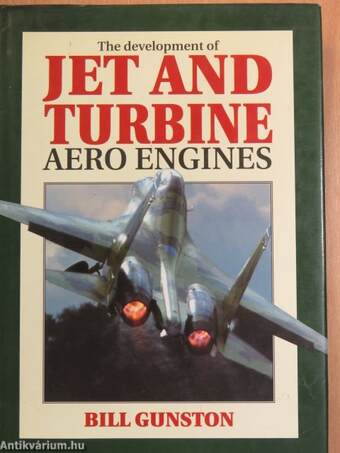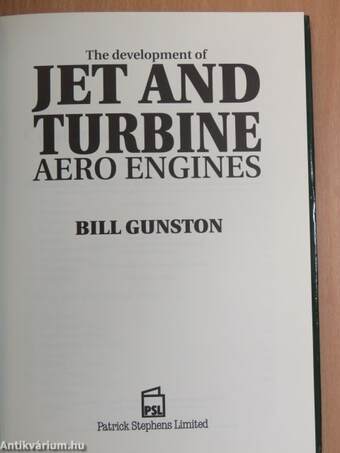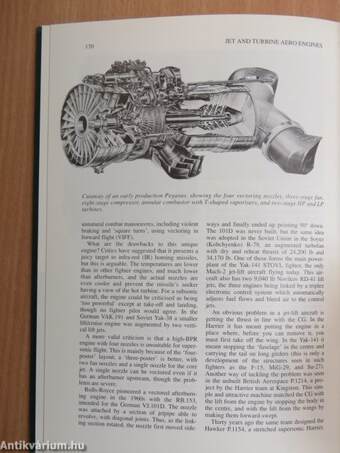1.067.339
kiadvánnyal nyújtjuk Magyarország legnagyobb antikvár könyv-kínálatát

VISSZA
A TETEJÉRE
JAVASLATOKÉszre-
vételek
The development of Jet and Turbine
Aero Engines
| Kiadó: | Patrick Stephens Limited |
|---|---|
| Kiadás helye: | Sparkford |
| Kiadás éve: | |
| Kötés típusa: | Fűzött kemény papírkötés |
| Oldalszám: | 224 oldal |
| Sorozatcím: | |
| Kötetszám: | |
| Nyelv: | Angol |
| Méret: | 24 cm x 17 cm |
| ISBN: | 1-85260-463-8 |
| Megjegyzés: | Fekete-fehér fotókkal, illusztrációkkal. |
naponta értesítjük a beérkező friss
kiadványokról
naponta értesítjük a beérkező friss
kiadványokról
Fülszöveg
The development of
JET AND TURBINE AERO ENGINES
The largest and heaviest transport aircraft, the highest flying reconnaissance aeroplanes and the fastest and most agile fighters are all powered by jet or gas-turbine engines. In its various forms this means of propulsion has become one of man's most useful and successful inventions. Written by a popular and highly regarded aviation author using language understandable to those without an engineering background, this book describes how jet and gas-turbine engines and their derivatives work, and explains the differences between jet, gas-turbine, rockét, ramjet, turboprop, and helicopter turboshaft engines. Their development and refinement started before the Second World War when there was little official support or fináncé. In contrast the investment made today in new engines can be astronomical. The change in attitűdé and the growth of the industry make a unique and fascinating story.
9781852604639
From the dawn of the present... Tovább
Fülszöveg
The development of
JET AND TURBINE AERO ENGINES
The largest and heaviest transport aircraft, the highest flying reconnaissance aeroplanes and the fastest and most agile fighters are all powered by jet or gas-turbine engines. In its various forms this means of propulsion has become one of man's most useful and successful inventions. Written by a popular and highly regarded aviation author using language understandable to those without an engineering background, this book describes how jet and gas-turbine engines and their derivatives work, and explains the differences between jet, gas-turbine, rockét, ramjet, turboprop, and helicopter turboshaft engines. Their development and refinement started before the Second World War when there was little official support or fináncé. In contrast the investment made today in new engines can be astronomical. The change in attitűdé and the growth of the industry make a unique and fascinating story.
9781852604639
From the dawn of the present century a number of inventors proposed various methods of jet propulsion. However, it was not until Frank Whittle, a young RAF pilot, persisted with next to no official support and little money that a practical jet engine was produced during the 1930s. Even then, it was not put into operational use untii near the end of the Second World War. Meanwhile a rival development team had been set up in Germany, with all the resources of a large and prosperous aircraft company. The struggles, successes and failures of these early developments make a fascinating story.
The differences between gas-turbine, jet, rockét, ramjet and helicopter turboshaft engines are fully explained here, and their history is traced from pioneering days through to today's highly complex and powerful units, as used in the latest wide-bodied airliners and high-performance military aircraft. The purpose of the various components of gas-turbine and jet engines, and how they work, is described in language understandable to those without an engineering background, avoiding complex mathematical formuláé. The development and refinement of gas-turbine and jet engines has been a remarkable success story, with almost every country in the world now linked by aircraft using these propulsion systems. The past 30 years have seen a vast improvement in the performance of large passenger and cargo aircraft, which have multiplied their carrying capacity by three, had their rangé doubled and safety improved by roughly 30 times, whilst their nőise levels have been reduced by more than 90 per cent. Bili Gunston is an acknowledged aviation expert with several hundred books to his credit including a companion volume, The Development ofPiston Aero Engines, and The World Encyclopaedia ofAero Engines. Vissza
Témakörök
- Idegennyelv > Idegennyelvű könyvek > Angol > Műszaki
- Műszaki > Géptan, gépészet > Gépelemek > Egyéb
- Műszaki > Géptan, gépészet > Egyéb
- Műszaki > Technika > Kutatás, fejlesztés
- Műszaki > Idegennyelv > Angol
- Műszaki > Közlekedés > Repülés > Repülők
- Műszaki
Bill Gunston
Bill Gunston műveinek az Antikvarium.hu-n kapható vagy előjegyezhető listáját itt tekintheti meg: Bill Gunston könyvek, művekMegvásárolható példányok
Nincs megvásárolható példány
A könyv összes megrendelhető példánya elfogyott. Ha kívánja, előjegyezheti a könyvet, és amint a könyv egy újabb példánya elérhető lesz, értesítjük.










